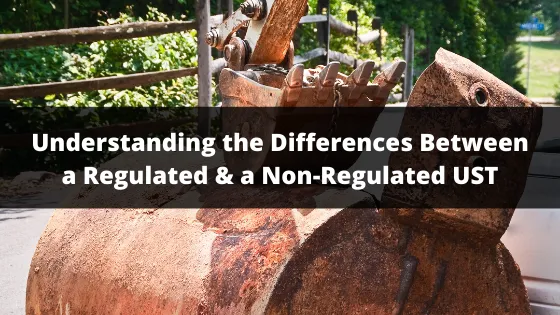Understanding the Differences Between a Regulated & a Non-Regulated UST
- Elk Environmental Services

With Spring being the perfect time for taking care of an old underground storage tank (UST), the question of what is a regulated tank often comes up. When talking about regulated and non-regulated USTs, it comes down to the substances stored inside them. Aside from being underground, a regulated UST is much smaller than a regulated aboveground storage tank (AST) in that it has a storage capacity of 110 gallons compared to 250 gallons (and more). These tanks are regulated because they contain regulated substances, which is why they are registered. According to the PADEP, underground storage tanks must be registered by the tank owner. This isn’t a new law; it’s been around since 1989. In 2015, the EPA revised the 1988 underground storage tank regulation and the 1988 state program approval regulation ( 40 CFR parts 280 and 281 ). The revision (final rule) was designed to help prevent and detect UST releases by adding more federal requirements, thus ensuring all USTs in the U.S. adhered to minimum standards. Just as there are stark differences between a UST and an AST, there are differences between regulated and non-regulated tanks.
The Regulated Tank
When a tank owner registers his or her UST, the state not only knows the location of the tank but what’s inside it. This provides valuable information to PA DEP’s programs that prevent and clean up releases. Releases are a major threat to the environment because they seep into the ground and travel to groundwater, polluting bodies of water (e.g. rivers and lakes). This is just one of the many reasons why we need wastewater treatment plants. Releases can also cause vapors that can enter underground areas, such as basements and parking garages. The vapors can cause damage to structures and humans due to fires, toxicity and asphyxiation.
A regulated tank (a registered tank) is entered into a government database that lists the UST’s use, storage capacity, substance, compartments … etc. When there is an issue with a UST, first responders and/or technicians have access to this information, helping them use the right equipment and safety practices. Regulated tanks also contain regulated substances , such as petroleum, hazardous chemicals, non-petroleum oils and pure ethanol (for blending). It is important to note that it is illegal to operate a regulated UST that is not registered. Also, a person who deposits a substance into an unregistered UST can be held liable for a release.
In addition to registering their USTs, tank owners must pay an annual registration fee. If a UST is removed from service, the owner must still pay the fee. However, if the tank is closed, the owner will no longer be charged. Tank closures must be done by a certified UMR/AMR technician , who utilizes the proper procedures to remove the tank with as minimal damage to the environment as possible.
A Non-Regulated Tank
As the name indicates, a non-regulated tank is not registered. There are certain types of USTs that do not need to meet the requirements of federal regulations per the 1988 UST regulation or the 2015 revision of the regulation. These tanks include:
- Farm and residential tanks with an 1,100 gallon or less storage capacity used to store motor oil for noncommercial use;
- Septic tanks;
- Tanks used for storing heating oil for consumptive use on premises;
- Flow-through process tanks; and
- Storage tanks in an underground area (e.g. basement) that are above the floor.
There are other types of USTs that are not regulated because they do not fully meet a particular requirement(s) of a federal regulation or they fall under another federal act (e.g. Clean Water Act). Also, there are some USTs that arepartially excluded from federal regulation because they only have to meet certain subparts of a federal regulation (e.g. 40 CFR 280.12 subpart A, F, H and I).
The tank owner is responsible for monitoring his or her tank for a release and clean up as well as reporting a release to local, state and/or federal agencies. Since these tanks are not registered, there is no annual fee. However, great care must still be given in their installation and closure to prevent damage to the environment.
Knowing the differences between regulated and non-regulated tanks will save you time and money, especially when it comes to following federal regulations. It’s also important when closing a regulated UST, since it requires the expertise of a UMR/AMR technician. Although USTs have many requirements, they are an important part of a residence, farm or business.
Contact us today to learn how we can help you with your underground storage tank closure!
Elk Environmental Services offers over 40 training programs specific to EPA, RCRA, DOT, PADEP and OSHA that will ensure your employees and company are both compliant and safe. Choose from a number of training areas based on your particular needs, such as transportation, hazardous waste, emergency response, and total compliance. Our experienced and knowledgeable trainers are committed to meeting your expectations. We can accommodate up to 30 students at our newly renovated Reading Training facility or we can create a customized training program at your office or venue. Check out Elk’s upcoming training courses today!
